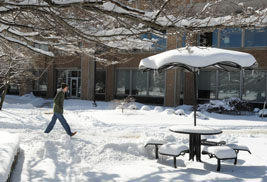Featured Article
2011 President’s Excellence Award Recipients Announced
Ten Kent State University employees are recipients of the third President’s Excellence Award.
read moreTaking the Bite Out of Cold Weather
Posted Jan. 9, 2012Kent State’s Office of Environmental Health and Safety offers tips for the winter season

Many cold-weather injuries result from falls on ice-covered
sidewalks, steps, driveways and porches. Kent State's
Office of Environmental Health and Safety offers tips to stay
safe during the winter season.
When the body is unable to warm itself, serious cold-related injuries may occur and permanent tissue damage may result.
Cold-related emergencies can occur even when temperatures are above freezing. These injuries can slowly overcome a person who has been chilled by low temperatures, brisk winds or wet clothing. The two main cold-related injuries are frostbite and hypothermia.
Frost Bite
Frost bite occurs when deep layers of skin and tissue become frozen, resulting in waxy white skin color and the skin becomes hard and numb. Frost bite usually affects extremities, such as the fingers, hands, toes, feet, ears and nose.
What Should Be Done
- Move the person to a warm dry area.
- Remove wet or tight clothing that may cut off blood flow to the affected area.
- Do not rub the affected area; rubbing causes damage to the skin and tissue.
- Gently place the affected area in a warm (105°F) water bath and monitor the water temperature to slowly warm the tissue. Warming the tissue too fast can cause tissue damage.
- After the affected area is warmed, it may develop blisters, become puffy and have a burning or numb feeling. When normal feeling, movement and skin color have returned, the affected area should be dried and wrapped to keep it warm.
- If there is a chance the affected area may get cold again, do not warm the skin. If the skin is warmed and then becomes cold again, it will cause severe tissue damage.
- Seek medical attention as soon as possible.
Hypothermia
Hypothermia is a medical emergency. A normal body temperature is 98.6° F. When hypothermia occurs, the body temperature drops below 95°F. When your body temperature drops this low, the heart, nervous system and other organs can't work correctly. Left untreated, hypothermia can eventually lead to complete heart and respiratory system failure. Symptoms of hypothermia include fatigue, drowsiness, slurred speech, uncontrolled shivering and irritable, irrational or confused behavior.
What Should Be Done
- Call 9-1-1.
- Move the person to a warm, dry area. Don’t leave the person alone.
- Remove any wet clothing and replace with warm, dry clothing or wrap the person in blankets.
- Have the person drink warm drinks if they are alert. Avoid drinks with caffeine (coffee, tea or hot chocolate) or alcohol.
- Have the person move their arms and legs to create muscle heat. If they are unable to do this, place warm bottles or hot packs in the armpits, groin, neck and head areas.
How to Protect Yourself
- Wear a hat or other protective covering to prevent body heat from escaping from your head, face and neck. Cover your hands with mittens instead of gloves. Mittens are more effective than gloves because mittens keep your fingers in closer contact with one another.
- Avoid activities that would cause you to sweat a lot. The combination of wet clothing and cold weather can cause you to lose body heat more quickly.
- Wear loose-fitting, layered, lightweight clothing. Outer clothing made of tightly woven, water-repellent material is best for wind protection. Wool, silk or polypropylene inner layers hold body heat better than cotton does.
- Stay as dry as possible. Get out of wet clothing as soon as possible. Be especially careful to keep your hands and feet dry, as it is easy for snow to get into mittens and boots.
Wintertime Slips, Trips and Falls
Walking on ice can be dangerous. Many cold-weather injuries result from falls on ice-covered sidewalks, steps, driveways and porches. Keep your steps and walkways as free of ice as possible by using rock salt or any other chemical de-icing compound. Sand may also be used on walkways to reduce the risk of slipping.
- Plan ahead to give yourself plenty of time.
- When walking on steps, use the hand railings and plant your feet firmly on each step.
- When walking on an icy or snow-covered walkway, take short steps and walk at a slower pace so you can react quickly to a change in traction.
- Streets and sidewalks that appear to have been cleared of snow and ice should still be approached with caution. Look out for "black ice." Dew, fog or water vapor can freeze on cold surfaces and form an extra-thin, nearly invisible layer of ice that can look like a wet spot on the pavement.
- Carrying heavy items can challenge your sense of balance. Try not to carry too much — you need to leave your hands and arms free to better balance yourself.
- If you do fall, try to avoid using your arms to break your fall. If you fall backward, make a conscious effort to tuck your chin so your head doesn't strike the ground full force.
- When entering a building, remove as much snow and water from your boots as you can; take notice that floors and stairs may be wet and slippery.
